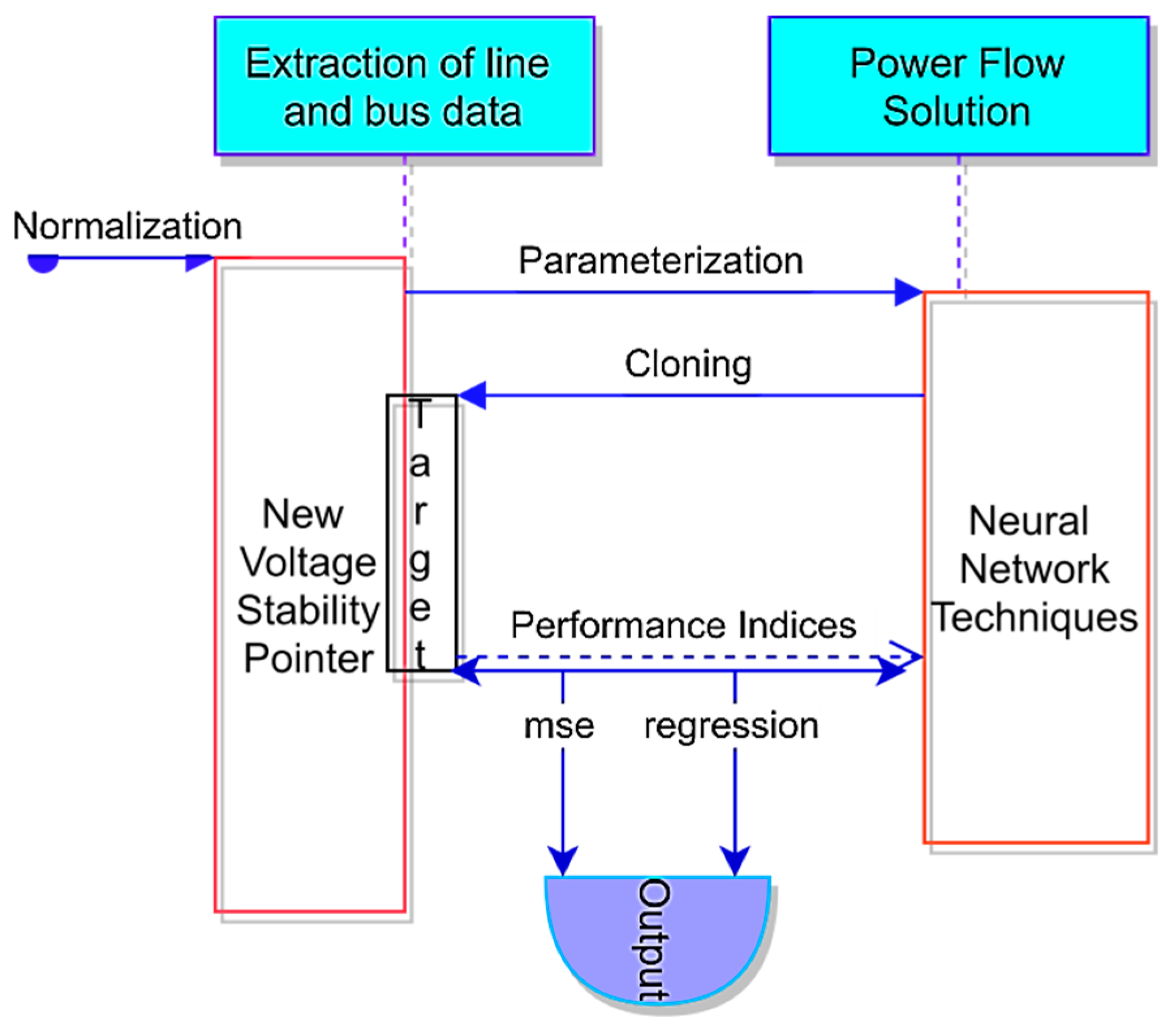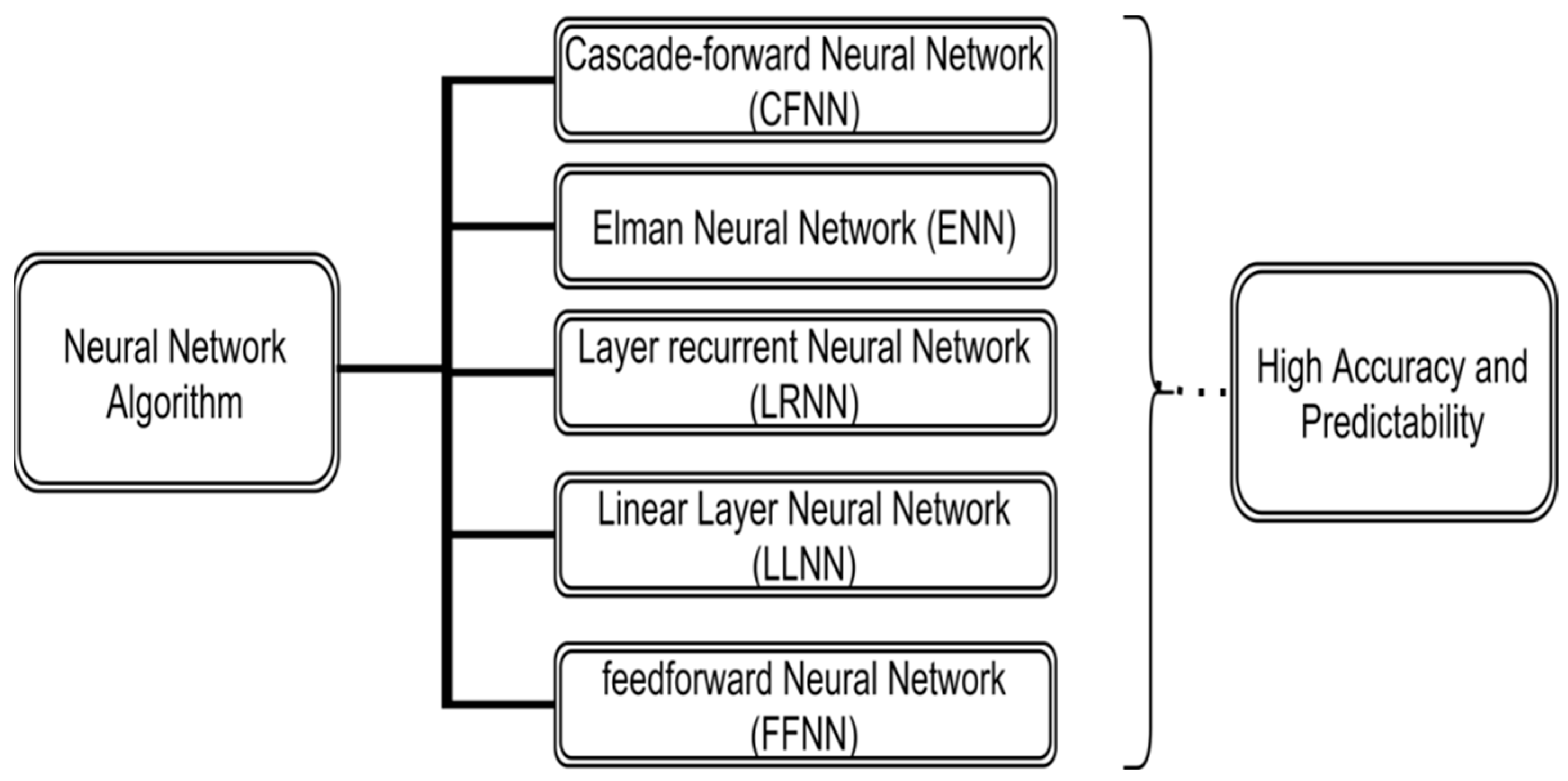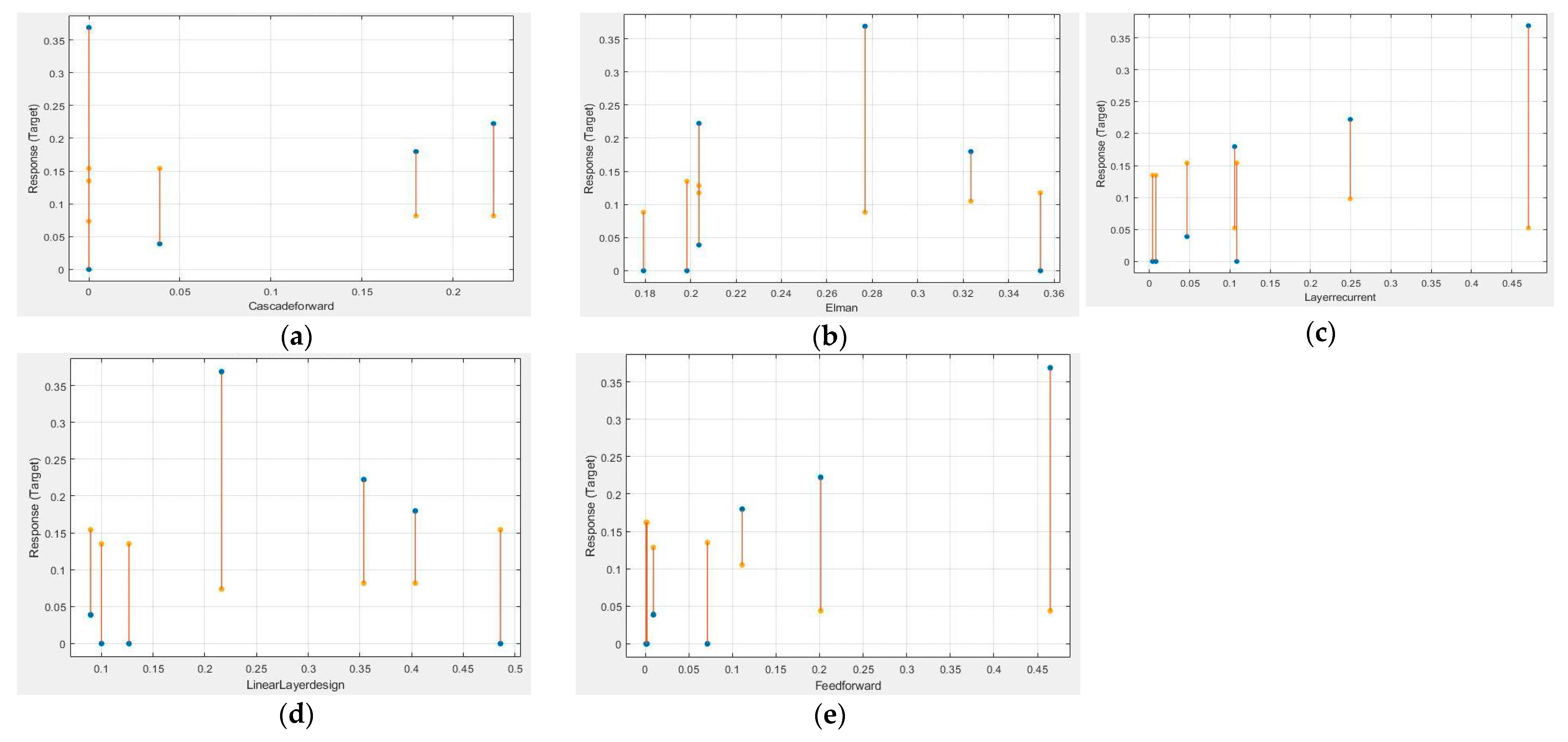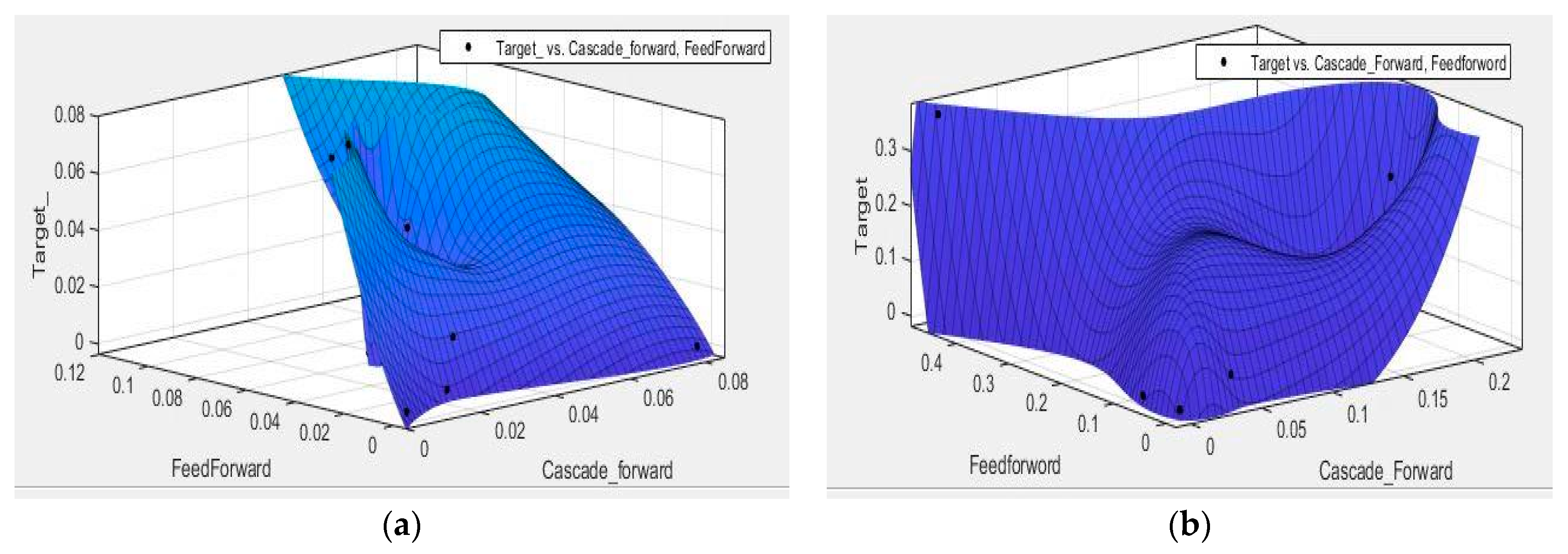Neural Network Based Approach for Steady-State Stability Assessment of Power Systems
Abstract
1. Introduction
2. Related Work
3. Methodology
3.1. Mathematical Modeling of the New Voltage Stability Pointer
3.2. Neural Network Algorithms
3.2.1. Cascaded-Forward Neural Network (CFNN)
3.2.2. Elman Neural Network (ENN)
3.2.3. Layer Recurrent Neural Network (LRNN)
3.2.4. Linear Layer Neural Network (LLNN)
3.2.5. Feed-Forward Neural Network (FFNN)
3.3. Levenberg-Marquardt Model (LMM)
4. Results and Analysis
4.1. Results
4.2. Performance Analysis of the Regression Learner Algorithm
4.3. Comparative Analysis of the Neural Networks
5. Conclusions
Author Contributions
Funding
Institutional Review Board Statement
Informed Consent Statement
Data Availability Statement
Acknowledgments
Conflicts of Interest
References
- Rahim, S.; Siano, P. A survey and comparison of leading-edge uncertainty handling methods for power grid modernization. Expert Syst. Appl. 2022, 204, 117590. [Google Scholar] [CrossRef]
- Mokred, S.; Wang, Y.; Chen, T. Modern voltage stability index for prediction of voltage collapse and estimation of maximum load-ability for weak buses and critical lines identification. Int. J. Electr. Power Energy Syst. 2023, 145, 108596. [Google Scholar] [CrossRef]
- Xie, H.; Liu, Y.; Li, Y.; Qiao, H. A prediction model based on artificial neural network for E1 HEMP coupling with distribution power lines. IEEE Trans. Power Deliv. 2022, 37, 5337–5344. [Google Scholar] [CrossRef]
- Fikri, M.; Cheddadi, B.; Sabri, O.; Haidi, T.; Abdelaziz, B.; Majdoub, M. Power flow analysis by numerical analysis and artificial neural network. Renew. Energ. Power Syst. Green Incl. Econ. 2018, 1–5. [Google Scholar] [CrossRef]
- Bayindir, R.; Demirbas, S.; Irmak, E.; Cetinkaya, U.; Ova, A.; Yesil, M. Effect of renewable energy sources on power system. In Proceedings of the 2016 IEEE International Power Electronics and Motion Control Conference, Varna, Bulgaria, 25–28 September 2016. [Google Scholar] [CrossRef]
- Khaki, B.; Kiliç, H.; Yilmaz, M.; Shafie-Khah, M.; Lotfi, M.; Catalão, J.P. Active fault tolerant control of grid-connected DER: Diagnosis and reconfiguration. In Proceedings of the IECON 2019-45th Annual Conference of the IEEE Industrial Electronics Society, Lisbon, Portugal, 14–17 October 2019; IEEE: Piscataway, NJ, USA, 2019; Volume 1, pp. 4127–4132. [Google Scholar]
- Celikel, R.; Yilmaz, M.; Gundogdu, A. A voltage scanning-based MPPT method for PV power systems under complex partial shading conditions. Renew. Energy 2021, 184, 361–373. [Google Scholar] [CrossRef]
- Gbadamosi, S.; Nwulu, I. A multi-period composite generation and transmission expansion planning model incorporating renewable sources and demand response. Sustain. Energy Techn. Assess. 2020, 39, 100726. [Google Scholar]
- Gbadamosi, S.; Nwulu, I. Reliability assessment of composite generation and transmission expansion planning incorporating renewable energy sources. J. Renew. Sustain. Energy 2020, 12, 026301. [Google Scholar] [CrossRef]
- Roy, P.; He, J.; Zhao, T.; Singh, Y.V. Recent advances of wind-solar hybrid renewable energy systems for power generation: A review. IEEE Open J. Ind. Electron. Soc. 2022, 3, 81–104. [Google Scholar] [CrossRef]
- Sanghami, S.V.; Lee, J.J.; Hu, Q. Machine learning enhanced blockchain consensus with transaction prioritization for smart cities. IEEE Internet Things J. 2022, 1. [Google Scholar] [CrossRef]
- Gupta, S.; Kazi, F.; Wagh, S.; Kambli, R. Neural network based early warning system for an emerging blackout in smart grid power networks. In Intelligent Distributed Computing; Springer: Berlin, Germany. [CrossRef]
- Almadhor, A. Intelligent control mechanism in smart micro grid with mesh networks and virtual power plant model. In Proceedings of the 2019 16th IEEE Annual Consumer Communications & Networking Conference, Las Vegas, NV, USA, 11–14 January 2019; pp. 1–6. [Google Scholar] [CrossRef]
- Sarker, I.H. Machine learning: Algorithms, real-world applications and research directions. SN Comput. Sci. 2021, 2, 160. [Google Scholar] [CrossRef]
- Sarker, I.H. Deep learning: A comprehensive overview on techniques, taxonomy, applications and research directions. SN Comput. Sci. 2021, 2, 420. [Google Scholar] [CrossRef] [PubMed]
- Liu, Y.; Zhao, L.; Liu, L.; Li, S.; Tong, S.; Chen, C. Adaptive neural network control for a class of nonlinear systems with function constraints on states. IEEE Trans. Neural Netw. Learn. Syst. 2021. [Google Scholar] [CrossRef] [PubMed]
- Khalil, K.; Kumar, A.; Bayoumi, M. Recongifurable hardware design approach for economic neural network. IEEE Trans. Circuits Neural Syst. II Express Briefs 2022, 69, 5094–5098. [Google Scholar] [CrossRef]
- Wang, Y.; Zhu, S.; Shao, H.; Feng, Y.; Wang, L.; Wen, S. Comprehensive analysis of fixed-time stability and energy cost for delay neural networks. Neural Netw. 2022, 155, 413–421. [Google Scholar] [CrossRef]
- Jaramillo, M.; Tipan, L.; Munoz, J. A novel methodology for optimal location of reactive compensation through deep neural networks. Heliyon 2022, 8, e11097. [Google Scholar] [CrossRef]
- Zhu, L.; Hill, D.; Lu, C. Hierarchical deep learning machine for power system online transient stability prediction. IEEE Trans. Power Syst. 2020, 35, 2399–2411. [Google Scholar] [CrossRef]
- Zhao, T.; Wang, J.; Lu, X.; Du, Y. Neural lyapunov control for power system transient stability: A deep learning-based approach. IEEE Trans. Power Syst. 2022, 37, 955–966. [Google Scholar] [CrossRef]
- Wang, T.; Liu, Y.; Qiu, G.; Ding, L.; Wei, W.; Liu, J. Deep learning-driven evolutionary algorithm for power system voltage stability control. Energy Rep. 2022, 8 (Suppl. 5), 319–324. [Google Scholar] [CrossRef]
- Yang, Y.; Zhang, X.; Yang, L. Data-driven power system small-signal stability assessment and correction control model based on XGBoost. Energy Rep. 2022, 8 (Suppl. 5), 710–717. [Google Scholar] [CrossRef]
- Naderi, S.; Javadi, M.; Mazhari, M.; Chung, C.Y. A machine learning-based framework for fast prediction of wide-area remedial control actions in interconnected power systems. IEEE Trans. Power Syst. 2022, 38, 242–255. [Google Scholar] [CrossRef]
- Bento, M. Load margin assessment of power systems using artificial neural network and genetic algorithms. IFAC 2022, 55, 944–948. [Google Scholar] [CrossRef]
- Badrudeen, T.U.; Ariyo FK Salau, A.O.; Braide, S.L. Analysis of a new voltage stability pointer for line contingency ranking in a power network. Bull. Electr. Eng. Inform. 2022, 11, 3033–3041. [Google Scholar] [CrossRef]
- Goh, H.; Chua, Q.; Lee, S.; Kok, B.; Goh, K.; Teo, K. Evaluation for voltage stability indices in power system using artificial neural network. Procedia Eng. 2015, 118, 1127–1136. [Google Scholar] [CrossRef]
- Bai, X.; Tan, J. Contingency-based voltage stability monitoring via neural network with multi-level feature fusion. IFAC-PapersOnLine 2020, 53, 13483–13488. [Google Scholar] [CrossRef]
- Shi, Z.; Yao, W.; Zeng, L.; Wen, J.; Fang, F.; Ai, X.; Wen, J. Convolutional neural network-based power system transient stability assessment and instability mode prediction. Appl. Energy 2020, 263, 114586. [Google Scholar] [CrossRef]
- Abdullah, A.; Ali, R.; Yaacob, S.B.; Mansur, T.M.N.T.; Baharudin, N.H. Voltage stability prediction in power systems using modified artificial neural network. In Proceedings of the International Conference on Advances in Electrical, Computing, Communication and Sustainable Technologies (ICAECT), Bhilai, India, 21–22 April 2022; pp. 1–6. [Google Scholar] [CrossRef]
- Calma, E.; Pacis, M. Artificial neural network-based voltage stability analysis of power transmission networks with distributed generation using phasor measurement unit synthetic data. In Proceedings of the IEEE Control and System Graduate Research Colloquium (ICSGRC), Shah Alam, Malaysia, 7 August 2021; pp. 1–6. [Google Scholar] [CrossRef]
- Khurana, B.; Titare, L. Improvement of power flow and voltage stability using UPFC with Artificial Neural Network in Matlab. In Proceedings of the IEEE International Symposium on Sustainable Energy, Signal Processing and Cyber Security (iSSSC), Gunupur Odisha, India, 16–17 December 2020; pp. 1–4. [Google Scholar] [CrossRef]
- Bingi, K.; Prusty, B. Neural network-based models for prediction of smart grid stability. In Proceedings of the 2021 Innovations in Power and Advanced Computing Technologies (i-PACT), Kuala Lumpur, Malaysia, 27–29 November 2021; pp. 1–6. [Google Scholar] [CrossRef]
- Zhang, H.; Shen, S.; Shen, Y. Power system transient stability evaluation based on multilayer perceptron neural network. In Proceedings of the 2021 China Automation Congress (CAC), Beijing, China, 22–24 October 2021; pp. 3313–3316. [Google Scholar] [CrossRef]
- Ramachandran, B.; Harris, S.; Youseff, T. Transient stability in power systems using a convolutional neural network. In Proceedings of the 2019 SoutheastCon, Huntsville, AL, USA, 11–14 April 2019; pp. 1–6. [Google Scholar] [CrossRef]
- Badrudeen, T.U.; Ariyo, F.K.; Gbadamosi, S.L.; Nwulu, I.N. A novel classification of the 330 kV Nigerian power network using a new voltage stability pointer. Energies 2022, 15, 7247. [Google Scholar] [CrossRef]
- Odesanya, I.; Isabona, J.; Jangfa, T.; Zhimwang, I. Casade forward neural network-based adaptive model for real time adaptive learning of stochastic signal power datasets. Int. J. Comput. Netw. Inf. Secur. 2022, 14, 63–74. [Google Scholar] [CrossRef]
- Lei, S.; Yi, W.; Yuan, D.; Guan, J. Application of elman neural network based on genetic algorithm in initial alignment of SINS for guided projectile. Math. Probl. Eng. 2019, 2019, 5810174. [Google Scholar] [CrossRef]
- Ian, G.; Yoshua, B.; Courville, A. Deep Learning; MIT Publisher: Cambridge, MA, USA, 2016; Available online: http://www.deeplearningbook.org/contents/rnn.html (accessed on 26 October 2022).
- Wang, J.; Chung, F.; Wang, J.; Wu, J. A fast learning method for feedforward neural networks. Neurocomputing 2015, 149, 295–307. [Google Scholar] [CrossRef]
- Sahoo, P.; Panda, R.; Satpathy, P.; Paul, S. Voltage stability monitoring based on feed forward and layer recurrent neural networks. In Proceedings of the IEEE Power India International Conference, Delhi, India, 5–7 December 2014. [Google Scholar] [CrossRef]
- Varshney, S.; Srivastava, L.; Pandit, M. ANN based integrated security assessment of power system using parallel computing. Int. J. Electr. Power Energy Syst. 2012, 42, 49–59. [Google Scholar] [CrossRef]
- Agrawal, A.; Pandey, S.N.; Srivastava, L.; Walde, P.; Singh, S.; Khan, B.; Saket, R.K. Hybrid deep neural network based generation rescheduling for generation rescheduling for congestion mitigation in spot power market. IEEE Access 2022, 10, 29267–29276. [Google Scholar] [CrossRef]
- El-Nasar, A.; Zaki, A.; Soliman, F.; El-Bardini, M. Hybrid deep learning diagonal recurrent neural network controller for non-linear systems. Neural Comput. Appl. 2022, 34, 22367–22386. [Google Scholar] [CrossRef]
- Christie, R. 30 Bus Power Flow Test Case. 1993. Available online: http://www.ee.washington.edu/research/pstca/pf30/pg_tca30bus.htm (accessed on 22 December 2022).







| Bus No | Minimum Load | Maximum Load | ||||||
|---|---|---|---|---|---|---|---|---|
| P (MW) | Q (MVar) | NVSP | Voltage Mag. (p.u) | P (MW) | Q (MVar) | NVSP | Voltage Mag. (p.u) | |
| 30 | 10.6 | 10.9 | 0.3053 | 0.919 | 25.6 | 25.9 | 0.9832 | 0.609 |
| 26 | 10.5 | 10.3 | 0.1943 | 0.912 | 20.5 | 20.3 | 0.4651 | 0.711 |
| 29 | 10.4 | 10.9 | 0.2110 | 0.945 | 25.4 | 25.9 | 0.6458 | 0.691 |
| Bus Name | Minimum Load | Maximum Load | ||||||
|---|---|---|---|---|---|---|---|---|
| P (MW) | Q (MVar) | NVSP | Voltage Mag. (p.u) | P (MW) | Q (MVar) | NVSP | Voltage Mag. (p.u) | |
| Gombe | 90.6 | 50.9 | 0.1242 | 1.174 | 125.0 | 135.0 | 0.1711 | 1.000 |
| Jos | 40.3 | 55.7 | 0.1372 | 1.140 | 120.0 | 105.0 | 0.3936 | 0.962 |
| Kano | 80.6 | 90.9 | 0.2091 | 1.112 | 250.0 | 150.0 | 0.4006 | 0.933 |
| Target | Neural Network Algorithm | ||||
|---|---|---|---|---|---|
| Cascade- Forward | Feed-Forward | Linear Layer (Design) | Layer Recurrent | Elman | |
| 0.0134 | 0.0359 | 0.0434 | 0.0198 | 0.0184 | 0.0306 |
| 0.0535 | 0.0319 | 0.0610 | 0.0169 | 0.0196 | 0.0313 |
| 0.0763 | 0.0248 | 0.0559 | 0.0226 | 0.0198 | 0.0355 |
| 0.0000 | 0.0221 | 0.0116 | 0.0231 | 0.0226 | 0.0369 |
| 0.0405 | 0.0351 | 0.0604 | 0.0222 | 0.0254 | 0.0371 |
| 0.0000 | 0.0323 | 0.0590 | 0.0196 | 0.0189 | 0.0319 |
| 0.0000 | 0.0817 | 0.0000 | 0.0417 | 0.0139 | 0.0344 |
| 0.0161 | 0.0271 | 0.0167 | 0.0274 | 0.0233 | 0.0369 |
| 0.0493 | 0.0588 | 0.1145 | 0.0344 | 0.0257 | 0.0452 |
| 0.0385 | 0.0324 | 0.0341 | 0.0288 | 0.0239 | 0.0374 |
| 0.0436 | 0.0385 | 0.0527 | 0.0540 | 0.0378 | 0.0470 |
| 0.0000 | 0.0036 | 0.0000 | 0.1114 | 0.0214 | 0.0081 |
| Target | Neural Network Algorithm Training Output | ||||
|---|---|---|---|---|---|
| Cascade- Forward | Feed-Forward | Linear Layer (Design) | Layer Recurrent | Elman | |
| 0.3689 | 0.0000 | 0.4646 | 0.2162 | 0.4708 | 0.2768 |
| 0.0389 | 0.0389 | 0.0094 | 0.0895 | 0.0466 | 0.2037 |
| 0.2223 | 0.2223 | 0.2013 | 0.3538 | 0.2495 | 0.2037 |
| 0.1797 | 0.1797 | 0.1112 | 0.4036 | 0.1058 | 0.3234 |
| 0.0000 | 0.0000 | 0.0020 | 0.1266 | 0.0080 | 0.1793 |
| 0.0000 | 0.0000 | 0.0714 | 0.4860 | 0.1085 | 0.3540 |
| 0.0000 | 0.0000 | 0.0010 | 0.1000 | 0.0039 | 0.1984 |
| Neural Network Model | Rmse | Training Time (s) | No of Iteration | Gradient | Regression | Rank |
|---|---|---|---|---|---|---|
| CFNN | 0.029316 | 0.82864 | 12 | 0.000117 | 0.000983 | 2nd |
| ENN | 0.031560 | 0.84766 | 6 | 4.84 × 10−5 | 0.000225 | 5th |
| LRNN | 0.030479 | 0.92653 | 7 | 0.000633 | 0.000633 | 4th |
| LLNN | 0.028165 | 2.92024 | 1000 | - | 0.000547 | 3rd |
| FFNN | 0.026290 | 0.89757 | 6 | 0.000234 | 0.000327 | 1st |
| Neural Network Model | Rmse | Training Time (s) | No. of Iteration | Gradient | Regression | Rank |
|---|---|---|---|---|---|---|
| CFNN | 0.14979 | 0.93095 | 6 | 0.00693 | 0.000333 | 1st |
| ENN | 0.16124 | 0.77200 | 6 | 0.00905 | 0.000663 | 4th |
| LRNN | 0.16480 | 0.86549 | 8 | 0.00206 | 0.000121 | 5th |
| LLNN | 0.15717 | 4.97786 | 1000 | - | 0.000446 | 3rd |
| FFNN | 0.15141 | 0.95489 | 20 | 0.00206 | 0.000350 | 2nd |
Disclaimer/Publisher’s Note: The statements, opinions and data contained in all publications are solely those of the individual author(s) and contributor(s) and not of MDPI and/or the editor(s). MDPI and/or the editor(s) disclaim responsibility for any injury to people or property resulting from any ideas, methods, instructions or products referred to in the content. |
© 2023 by the authors. Licensee MDPI, Basel, Switzerland. This article is an open access article distributed under the terms and conditions of the Creative Commons Attribution (CC BY) license (https://creativecommons.org/licenses/by/4.0/).
Share and Cite
Badrudeen, T.U.; Nwulu, N.I.; Gbadamosi, S.L. Neural Network Based Approach for Steady-State Stability Assessment of Power Systems. Sustainability 2023, 15, 1667. https://doi.org/10.3390/su15021667
Badrudeen TU, Nwulu NI, Gbadamosi SL. Neural Network Based Approach for Steady-State Stability Assessment of Power Systems. Sustainability. 2023; 15(2):1667. https://doi.org/10.3390/su15021667
Chicago/Turabian StyleBadrudeen, Tayo Uthman, Nnamdi I. Nwulu, and Saheed Lekan Gbadamosi. 2023. "Neural Network Based Approach for Steady-State Stability Assessment of Power Systems" Sustainability 15, no. 2: 1667. https://doi.org/10.3390/su15021667
APA StyleBadrudeen, T. U., Nwulu, N. I., & Gbadamosi, S. L. (2023). Neural Network Based Approach for Steady-State Stability Assessment of Power Systems. Sustainability, 15(2), 1667. https://doi.org/10.3390/su15021667








